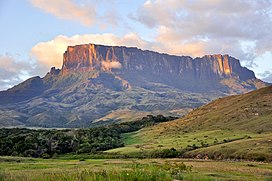
Back Tepui AST Тепуи Bulgarian Tepui Catalan Tepui Czech Tepui Danish Tepui German Tepui Esperanto Tepuy Spanish Tepui Estonian Tepui Basque
| Tepui | |
|---|---|
 | |
 Ecoregion territory (in purple) | |
| Ecology | |
| Realm | Neotropical |
| Biome | tropical and subtropical moist broadleaf forests |
| Borders | |
| Geography | |
| Area | 50,675 km2 (19,566 sq mi) |
| Countries | |
| Conservation | |
| Conservation status | Relatively stable/intact[1] |
| Protected | 37,658 km2 (74%)[2] |
A tepui /ˈtɛpwi/, or tepuy (Spanish: [teˈpuj]), is a table-top mountain or mesa found in South America, especially in Venezuela and western Guyana. The word tepui means "house of the gods" in the native tongue of the Pemon, the indigenous people who inhabit the Gran Sabana.
Tepuis tend to be found as isolated entities rather than in connected ranges, which makes them the host of a unique array of endemic plant and animal species. Notable tepuis include Auyantepui, Autana, Neblina, and Mount Roraima. They are typically composed of sheer blocks of Precambrian quartz arenite sandstone that rise abruptly from the jungle. Auyantepui is the source of Angel Falls, the world's tallest waterfall.
© MMXXIII Rich X Search. We shall prevail. All rights reserved. Rich X Search